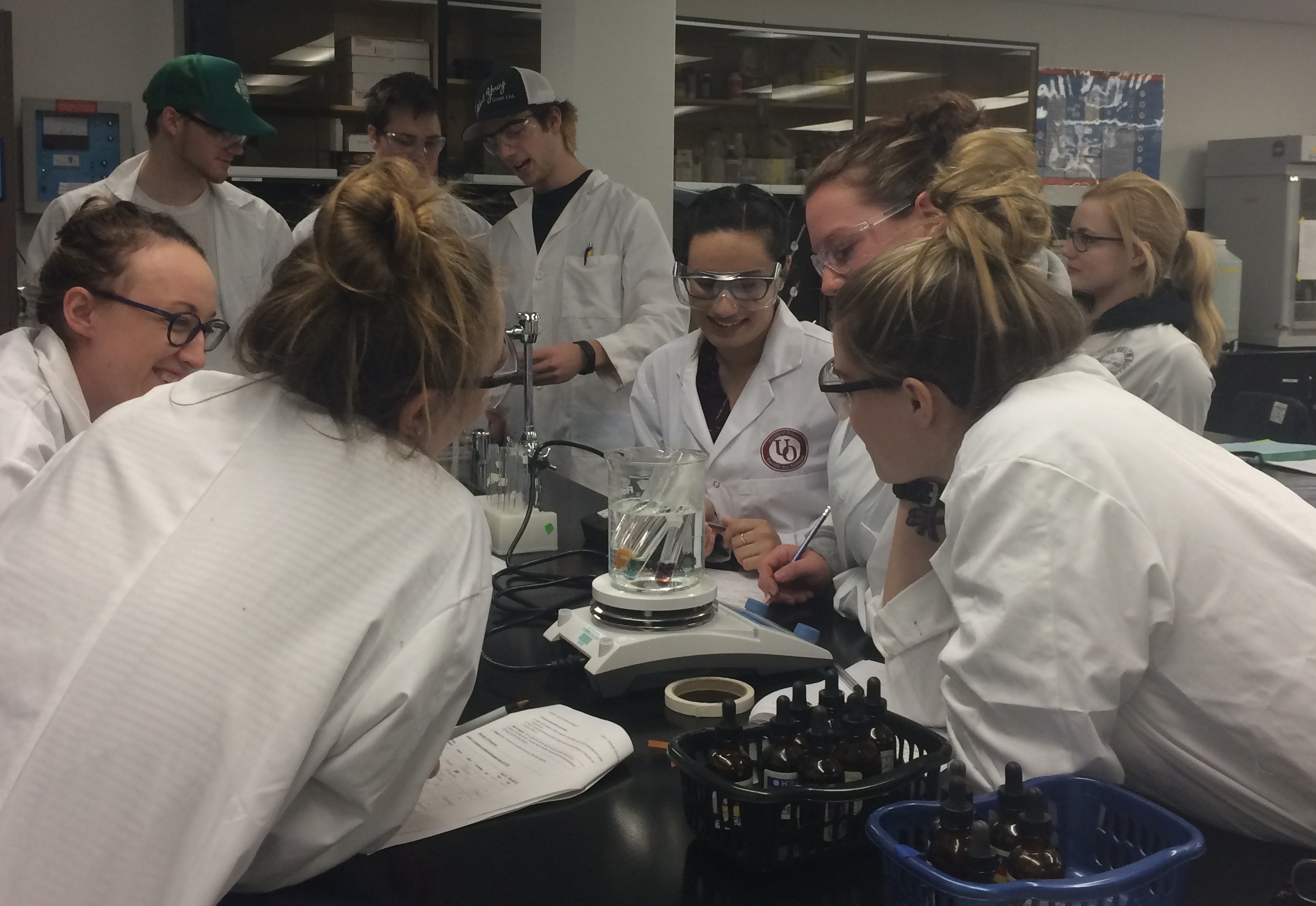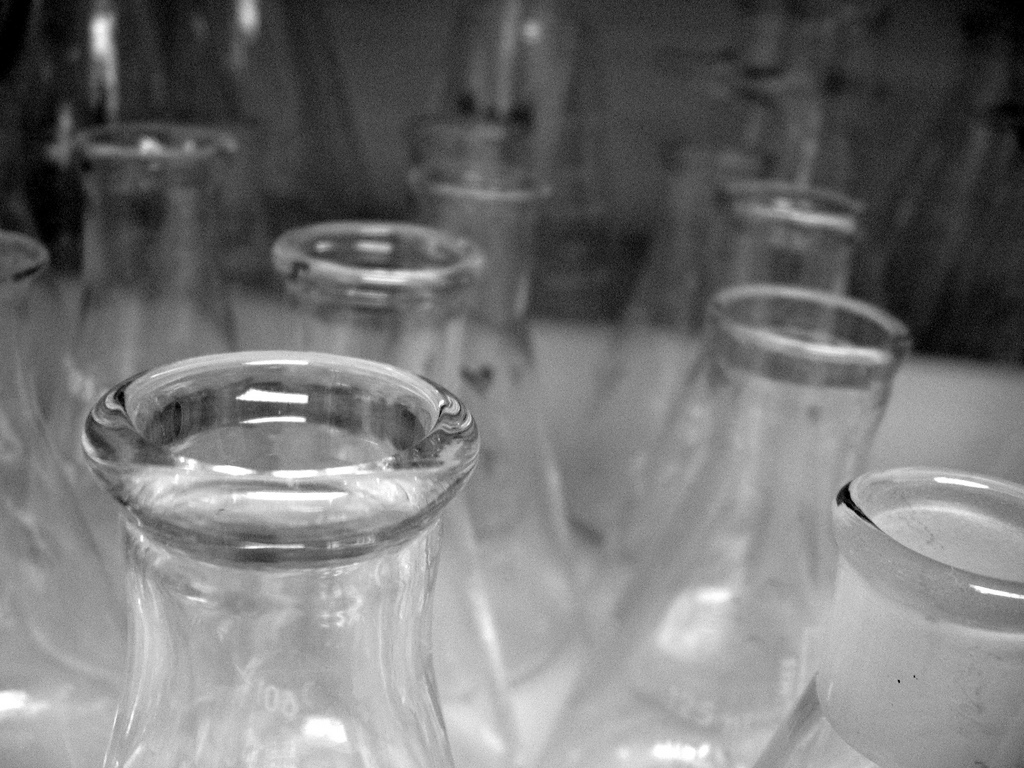10
Interpreting Student Work in Laboratory Assessments
Kari Draker-Fortis
By Kari-Draker Fortis, Fleming College
Introduction
What is the best way to assess student laboratories in an introductory science course? If you posed this question to a lab instructor, chances are they will have a lot to say and likely more questions than answers. Do you have students submit formal lab reports? Do you assess group work? Lab skills? How do you manage the marking of all those labs?
I have tackled these questions personally (often with a mountain of labs looming at my dining room table), with colleagues, and with larger groups of educators from college and university. One important theme that emerges from discussion is always the goal of the labs themselves. What do we want students to learn? What are the transferable skills that we want students to take away? These skills include lab-based competencies but also life skills. We want students to come prepared and ready to learn.
Introductory labs, regardless of discipline, follow the same general format. An overview of the lab objectives and background information is presented, with students completing some pre-work beforehand. The class engages in an experiment or set of lab activities that may involve hypothesis generation, recording and analyzing data, drawing conclusions, and answering questions. Commonly, student lab work is then submitted to their instructor for assessment.
I have come to the realization that the method of lab assessment has a significant impact on student preparedness, engagement, and overall effort. I can tell you what has not worked for me and for students in the past. In general, students learn less from a lab that is marked in agonizing detail. By this I mean that every question, table, graph, and labeling exercise is assessed and part-marks awarded. Student motivation can become more about the marks and less about the learning. Weaker students start to rely on stronger students for “wording” of answers, leading to a slippery slope of academic integrity issues. Other students rush through the work, often skipping steps, with little to no motivation to learn important concepts or lab skills. So in terms of interpreting student results, this method of lab marking, for me, does not accurately reflect what most students are learning. It provides little direct evidence of both lab competencies and understanding of lab content.
So again, I loop back to some familiar questions: What do we want students to learn? What are the transferable skills that we want students to take away?
What follows is an overview on what has been an interesting transition for me in evaluating student lab work. My hope is that an idea or two resonates and that, regardless of subject area, you are motivated to try something new in assessing students.
The Learners
I had an excellent opportunity to try out some new ideas for lab assessment when I redeveloped and delivered two core biology courses with Fleming’s Preparatory Health Science (PHS) program. I had the same group of students for lecture and lab, teaching them in both the fall and winter semesters. This was ideal as I could be consistent in assessing their labs and their understanding of course material over an entire academic year.
This particular group of PHS students had varying levels of prior knowledge in biology. Some have completed university-stream courses in high school. Others have already earned college diplomas and university undergraduate degrees. Regardless of background, the goal is to move on to an undergraduate Nursing program after completion of the PHS certificate. During their time at Fleming, students prepared for the academic rigor of university as they complete core courses in biology, chemistry, math, and English.

Within the laboratory space, learners have access to materials and equipment typically found in chemistry, biology, and anatomy & physiology teaching labs. In any given lab period, students could be testing a hypothesis, identifying bones on a skeleton, analyzing a human torso model, utilizing microscopes, or performing dissections.
Overview of Lab Assessment Changes
The most significant change was the inclusion of in-lab assessments. During a typical lab session, student groups were evaluated on a lab competency or their verbal response to a content-specific question that I pose to them during lab.
Students still completed lab work as described in the introduction. One important change was that they no longer handed it in. Students took their lab with them and were expected to check over their work and correct it by referencing a secured answer file posted to the Learning Management System (LMS). The secured file (in theory) prevented them from printing out the answers. Instead, students were strongly encouraged to review the answers on their device and correct/add to their own responses. In doing so, the goal was for students to engage in an ongoing cycle of review, reflection, and better retention of lab concepts as the semester progressed.
In the next lab period, students used their corrected lab work as a resource to complete a brief (10-15 min) post-lab assessment (PLA). The PLAs were short but comprehensive and could include some application and extension of previous lab content.
Some Considerations
As I prepared to assess the labs differently, there were many considerations that may serve as useful “tips” for anyone wanting to make similar changes.
Start with a good set of well-developed lab curriculum. Ideally, the kinks have all been worked out and students can complete all activities (including a brief lab assessment, Q&A discussions, and lab clean-up) within the lab time.
Create a generic grading checklist that can be used during the lab to assess student behaviours, performance, and understanding of core concepts. Examples of suggested criteria is included below:
- Was any pre-work assigned? Check and initial at the beginning of lab.
- Is the student prepared with required PPE (lab coat, safety goggles)?
- Does the student have required materials – handout, lecture notes, text?
- Is the student actively engaged with lab tasks & group?
- Can the student demonstrate a selected lab skill (specific for lab)?
- Can the student answer specific questions posed by instructor (Q&A)?
- Did the student complete the lab? Check the work and initial it.
Have a routine. A typical lab starts with collecting and initialing the pre-lab work. The students complete a post-lab assessment based on the previous week’s lab for the first 10-12 minutes of the lab. You can then briefly overview the lab activities, including any specifics on materials, equipment, and safety notes. At this point you can also communicate to students the lab skill and/or Q&A topic that will be assessed. Students then work in groups to complete the lab activities as the instructor circulates to answer questions, observe student skills, and conduct the Q&A. Once students complete the lab handout, you can quickly look over their work and initial it as complete.
Have your answer keys ready. As students are no longer submitting their lab work at the end of lab, many will want to look at the answers ASAP. Have the answer keys ready to be released on the course LMS as soon as your last lab session is complete. Specialized software like Adobe Reader XI or an equivalent can be used to generate a secure answer key with printing restrictions.
Student Feedback to Date
Most PHS students have communicated positive feedback regarding the way their labs were assessed in biology. During the first term, many learners expressed appreciation for the ongoing reminders to complete their pre-labs, correct their lab work, and come ready for the post-lab assessment. The majority of students became comfortable with the in-lab evaluations and were aware of what to expect when they got to class.
Early in the second semester, I was happy to hear a group of students explain to one another why they could not print out the answer keys. The consensus was that it was because they were supposed to correct their work, and by doing so, learn from their mistakes and remember the concepts. Even though I had mentioned this to the group frequently, it was rewarding to hear the “buy-in” from students.
Towards the end of the second biology course, I solicited more formal feedback from the group. I asked them whether the lab assessment method helped their learning and asked them to explain why or why not. The written responses I received varied, but the general consensus was again positive. The majority of students recognized that they learned and retained the lab concepts better by the cycle of in-lab evaluations, correction/revision, and completion of the post lab assessments. Many commented that studying for tests became easier as they already had corrected lab work to study from. There were a few students who communicated that they would have preferred to just hand their labs in and get graded on their submission, mostly because they were most comfortable with this method of evaluation from past courses.
My Reflection
I learned a great deal from implementing this revised method of lab evaluation. I particularly enjoyed the Q&A sessions with students and found it extremely useful in identifying learner strengths and weaknesses. It also provided an opportunity for me to support students as they realized that is was OK not to have the correct answer initially.
Surprisingly, I saw no real difference in the time I spent marking and prepping materials for the lab sessions. Instead of marking completed labs, I was busy marking the post-lab assessments and preparing the next weeks assessment. I planned out the lab Q&A for that week or spent time identifying the lab competency to observe. I do feel as though I used my time more wisely, however, with the end result being a more meaningful set of lab assessments.
As I look ahead to future lab development, I would definitely change a few aspects of the methods described here. Specifically, I would consider culminating the weekly post lab assessments into a couple of lab quizzes. This would increase precious lab time for students and also give them a break from weekly assessments. In addition, I would likely collect the lab work at the end of the lab sessions. I would not mark the lab work in great detail (as I know this hasn’t worked in the past), but I would look it over and assess overall understanding of lab topics. A rubric that incorporates both the in-lab assessments and an overall evaluation of the completed lab work may be a viable option and good use of my next development time.
As with any teaching or learning tool, methods of assessment can be treated as an ongoing “work in progress”. What works for some learners and students groups may not work for others. For educators, this means that we must always be interpreting student results, collecting feedback, and thinking ahead to the next curriculum change.
About the Author
Kari has been a faculty member at Fleming College since 2004 where she has taught, developed, and revised many science-based courses. Kari has acted as science and program coordinator in the past, and recently completed a secondment within the teaching and learning department at the college.

Photo credit: “Project 365 #315: 111113 Measuring Up” flickr photo by comedy_nose https://flickr.com/photos/comedynose/10808190836 shared into the public domain using (PDM)

